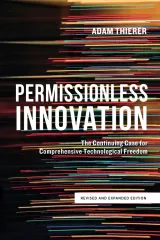- | Technology and Innovation Technology and Innovation
- | Expert Commentary Expert Commentary
- |
Intelligent Vehicles Could Save Lives
Unleashing the powerful potential of permissionless innovation for autonomous vehicle technology could start to alleviate some of the known, and clearly detrimental, harms to drivers and passengers this holiday season. That would be something for which we can all be truly thankful.
The American Automobile Association estimates that 43.6 million Americans will take extended trips during this Thanksgiving holiday season. Of those, approximately 90 percent – or 39 million people – plan on traveling by car. And tragically, according to the National Safety Council, some 418 Americans may lose their lives on the roads this Thanksgiving, in addition to over 44,000 injuries from car crashes.
This is why the debate over new “intelligent vehicle” and “driverless car” technologies is so important: Anything we can do to decrease driver error will help save many lives and reduce the cost of accidents. The technologies help automate many driving functions and could be in even more vehicles soon, assuming public policies don’t throw up unnecessary roadblocks to their development.
Last holiday season, the number of traffic-related fatalities fell below the quarter-century average, but with gas prices holding well below last year’s average of $3.27 during the same time, more Americans will travel by car. With more people driving, longer distances being traveled and the increased potential for “Black Wednesday” alcohol abuse, the prospect for disaster looms large during this holiday.
Many of these accidents, and fatalities, could be a thing of the past in coming years as intelligent vehicle technology begins to mature, alleviating many of these roadway perils. With regulators acting as gatekeepers to what’s allowed on the road, however, these technologies may be condemned to bureaucratic limbo; that is, unless regulatory agencies embrace the concept of “permissionless innovation.”
The essence of permissionless innovation is the idea that, in the absence of proof that a particular technology or idea will cause real, immediate and clear harm to society, innovation should be unimpeded by preemptive regulations. The hurdles that innovators and entrepreneurs face in bringing new technologies to market should not include precautionary regulations that stifle technological development, especially as it relates to autonomous vehicles. Such prescriptions are unlikely to yield the effects regulators anticipate. They are, however, more likely to spawn unintended consequences that could, among other things, hamper innovation, decrease economic growth and result in ongoing costs to society.
Among these costs are the more than 33,000 lives lost on American roads annually, due to driver error. How many lives could be saved if some of those drivers one day used autonomous vehicles?
In addition to fatalities, the National Highway Traffic Safety Administration points out that over 2.3 million people were injured in automobile crashes in 2012 alone – over 169,000 of which were children under the age of 14. Motor vehicle crashes like these are, in fact, the leading cause of death for children between the ages of 11 and 14. Every new development that pushes us closer to integrating this new technology into the mainstream means fewer fatalities.
With these safety issues in mind, policymakers ought to embrace the concept of permissionless innovation and avoid trying to predict every possible harmful scenario that might result from the introduction of this new technology. Flexible and creative solutions that could most ideally solve problems as they arise can only develop in a policy framework that promotes regulatory patience. There will be challenges, but progress can only occur when we accept a certain amount of risk and allow experimentation with new technologies. As was the case with the telephone, radio, the Internet and almost every other modern innovation, human adaptation and social acclamation will likely provide the best solutions to how we incorporate these technologies into daily life.
We should not delay this trial-and-error process based on the mistaken perception that we can anticipate every worst-case scenario that might result from integrating driverless vehicles into our transportation system. Inaction has its costs, too. Every day, approximately 92 people die from roadway accidents caused by human error.
Unleashing the powerful potential of permissionless innovation for autonomous vehicle technology could start to alleviate some of the known, and clearly detrimental, harms to drivers and passengers this holiday season. That would be something for which we can all be truly thankful.
